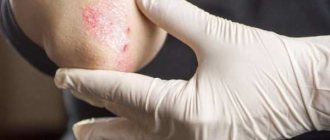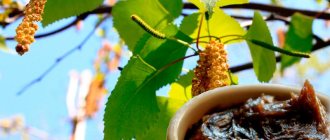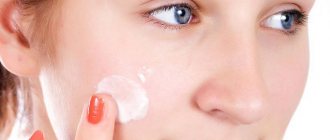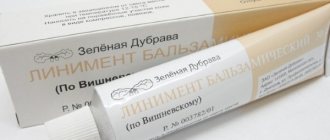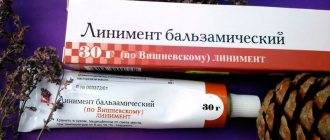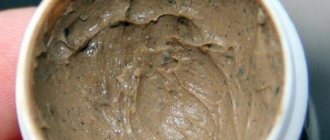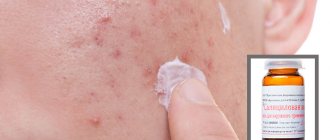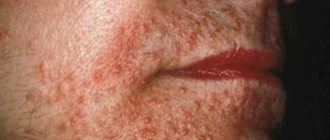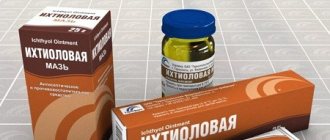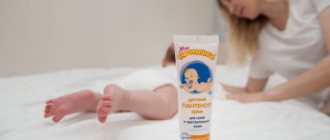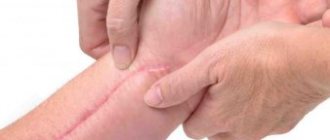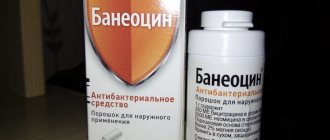Balsamic liniment according to Vishnevsky is a liquid ointment of a yellowish-brown color with a specific odor for external use. In pharmacies it is sold in aluminum tubes, dark glass jars, and there are also rectal suppositories with ointment.
It is believed that liniment has anti-inflammatory, bactericidal, antiseptic, and local irritant effects. At the site of the outbreak, blood circulation is activated, which accelerates tissue regeneration. You should know when liniment is used, what the benefits and harms are, what contraindications exist, and whether Vishnevsky ointment can be applied to an open wound.
Composition and properties of A. Vishnevsky’s ointment for purulent abscesses
The product belongs to the group of antibacterial and anti-inflammatory drugs. Code - ATX D08AX. In appearance it is a homogeneous ointment with a specific odor. Color - yellow, yellow-green, green-brown. The drug contains:
- Xeroform – binds to proteins, forms albuminates. The exudation of the abscess is reduced, a protective membrane is formed that protects the nerve endings from irritation. The active substance of the ointment invented by Vishnevsky interacts with the bacterial flora, which causes its inactivation. When used, the severity of inflammation of the abscess and pain syndrome decreases.
- Birch tar is a natural antibacterial agent. It has antimycotic and antiparasitic properties.
The active components of A. Vishnevsky's ointment enhance each other's effect, improve blood supply to the tissues around the abscess, abscess, and prevent secondary infection. This accelerates the maturation of the boil and the cleaning of the wound.
Solcoseryl
The drug is available in ointment and gel forms. The drug contains a natural component: blood extract of young calves. It is used in the treatment of minor injuries, frostbite, 1st and 2nd degree burns, bedsores. Healing ointment for open wounds Solcoseryl should be applied to the cleaned surface of the wound twice a day.
Wound healing ointments for open wounds Actovegin and Solcoseryl are identical in their action and active component to the blood extract of young calves. Actovegin is also available in the form of ointment and gel.
How to use Vishnevsky's liniment for the treatment of open and closed purulent wounds and abscesses
A. Vishnevsky's ointment is used only for the treatment of skin. Before use, you should consult a doctor to rule out other diseases of the dermis, system-wide pathologies accompanied by the formation of ulcers and abscesses.
Before using liniment, the affected area should first be cleared of white masses and necrotic tissue. Vishnevsky ointment is applied to an open purulent wound in a thin layer. It is possible to soak a gauze napkin with it.
The dressing is changed 2-3 times a day. The course of treatment with ointment depends on the patient’s reaction, the activity of the bacterial flora, and can range from 6 to 20 days. The purpose of using Vishnevsky's drug is to completely clean the abscess, wound from purulent masses, and epithelize tissue.
The use of ointment for compresses for abscesses is prohibited. Air access is a prerequisite for normal healing.
Treatment of closed wounds and internal cavities of the body filled with pus is not carried out using A. Vishnevsky’s ointment. It is indicated for external use. In this case, only the outer area is processed and cleaned. In the deep layers of the skin, the inflammatory process continues.
For abscesses, closed abscesses, phlegmon, carbuncles, surgery is indicated. The doctor drains and cleans the cavity filled with pus. After removing the masses, it is possible to use balsamic liniment according to Vishnevsky.
In the postoperative period, the drug is applied according to the manufacturer's instructions or as recommended by the doctor. The frequency of changing bandages on abscesses is 2–3 times a day.
Treatment with balm
A few words about first aid for wounds. Primary wound treatment is required:
- Never touch the wound directly with your hands;
- if possible, remove all foreign bodies if they are there;
But this help does not replace medical care, so you need to see a doctor. If the wound is not deep and treatment at home is possible, then at the pharmacy you need to purchase dressings (sterile bandages), alcohol for treating scissors, solutions of hydrogen peroxide, furacillin and ointment for open wounds, such as ichthyol.
Wound healing ointments come in different consistencies: cream and gel. Only gel ointments can be applied to wet wounds. Ointments in the form of a cream form a kind of film on the surface of the wound, which stops the rapid healing process.
Liniment is considered a universal remedy; it can be used for both adults and children. Before starting treatment, individual intolerance must be taken into account. Do not use the product on open purulent and bleeding wounds. Also, too long use dries the skin very much.
Liniment is used for such ailments as:
- burns,
- boils,
- inflammation of the ovaries,
- thrombophlebitis,
- pimples and blackheads,
- haemorrhoids,
- frostbite,
- bedsores,
- psoriasis and skin diseases.
There are good recipes using the medicine.
- Gently wash the skin with warm water and soap, removing dirt or remnants of “other cosmetics” from the surface of the skin. Any cream, fat, or dirt on the skin will reduce the effectiveness of Vishnevsky’s liniment and prevent us from getting rid of the problem as quickly as possible.
- There is no need to squeeze, pierce, or cut anything yourself at home. This can only be done by a doctor or an experienced nurse. In principle, cleaning the pus and expanding the channel for its exit to the outside before applying Vishnevsky’s liniment is the correct method for treating purulent inflammation, but not for home conditions, but for a qualified physician.
- There is no need to rub the ointment into the skin - this does not help, there is no need to smear a small amount of balsamic liniment. Don't be shy, the drug is inexpensive at the pharmacy.
- The drug is applied to the abscess in a thick layer, at least 1-2 mm thick. If we put more Vishnevsky liniment, it will be better, we will get rid of inflammation faster. Naturally, everything should be within reasonable limits and there is no need to take self-treatment to the point of “absurdity at home.”
- Next, a bandage is applied, most often a gauze bandage, a bactericidal patch or a thick sanitary napkin. Please note that a significant part of the ointment will be absorbed into the gauze, so it makes sense to “put more” of the drug.
- If necessary, the bandage, which plays the role of a kind of tampon soaked in Vishnevsky's liniment, is fixed with a bit or a regular plaster. Sometimes special medical glue is used - this is at your discretion. The main thing is to ensure that the bandage does not move from the selected place on the skin.
- How long, how long should the ointment remain on the site of inflammation? The drug does not help quickly and immediately. We should not remove the bandage for at least 4-6 hours, but this is the minimum. It is best not to remove the bandage for 10-12 hours. For outpatient and inpatient treatment of an abscess in a hospital, clinic, or medical center, dressing is prescribed once a day. At home, when self-treating an abscess, you should follow the same scheme for using balsamic liniment according to Vishnevsky.
- When dressing, not only the bandage is removed and the current condition of the skin is examined, but also the remainder of the previously applied Vishnevsky ointment for the abscess, which has not been absorbed into the removed bandage, is carefully wiped off without pressure. To remove Vishnevsky's liniment, you can use a cotton swab, a piece of gauze, a piece of bandage or a medical napkin. They do not have to be sterile, but it is advisable to use only clean materials.
- Even if it seems to you that after Vishnevsky’s ointment the abscess has increased, we still apply a new layer of balsamic liniment, spreading it on the same place. Or we slightly increase the area of application of the ointment, covering the area of redness and swelling - this should be looked at locally.
- If the condition of your skin causes you concern, and the progress of self-treatment at home seems “suspicious,” consult a doctor, maybe a regular emergency room or directly to a surgeon. Let the doctor examine you. Maybe it’s too late for you to treat the abscess with Vishnevsky ointment, and in order to get rid of it, you already need qualified surgical help.
- If we continue self-treatment of the abscess at home, then we simply change the bandage with ointment, balsamic liniment according to Vishnevsky, once a day until the pus comes out and the inflammation completely disappears and healthy skin without scars, cicatrices and spots Although in case of severe inflammation accompanied by a large amount of pus or in cases that do not heal for a long time, a small scar may remain.
Is it possible to use the ointment invented by Vishnevsky to draw out pus from a pimple?
A pimple is an inflammatory process affecting the hair follicle or developed due to blockage of the sebaceous gland duct or pores on the skin. There is no indication for acne treatment for the use of surgeon Vishnevsky's ointment.
Liniment is used in the following cases:
- furunculosis - damage to the hair follicle by staphylococcus. The ointment is indicated at the stage of formation of a purulent core;
- abscess or boil;
- bedsores - areas that have been subjected to prolonged compression as a result of immobilization of the patient;
- burns;
- inflammatory processes in the lymph nodes;
- trophic ulcers;
- frostbite.
In all cases, treatment is prescribed by the doctor after a visual examination of the patient and the exclusion of contraindications to the use of liniment. Before using Vishnevsky ointment for an abscess on a finger or toe, the stage and reasons for its development should be identified.
Rules for using the product
There are several ways to apply ointment to an open wound. For the procedure you will need gauze, a bandage, a tampon, and a spatula. An important condition for the result is the application of Vishnevsky’s liniment strictly according to the instructions.
- The ointment should be applied to clean skin. Take a bath or shower before doing this.
- Take a wooden spatula or other convenient tool for liniment.
- On an open wound, apply a thin layer of the product on gauze folded several times. The spatula will help distribute the medicine evenly.
- Apply a compress.
- Secure the top with a bandage.
- Keep Vishnevsky ointment on the wound for 12 hours or 24 hours. Compresses need to be changed twice a day.
When not to use ointment and what can be substituted
According to the instructions, it is prohibited to use Vishnevsky ointment for abscesses in the following cases:
- intolerance to phenol compounds;
- allergic reactions to other components of the ointment in the past.
There are no system-wide side effects. Discomfort may occur at the site of application of Vishnevsky balm: itching, redness of the skin, swelling, rash. In this case, the use of ointment to suck out pus from the abscess should be stopped.
How to replace surgeon Vishnevsky’s ointment when treating a purulent abscess:
- Ichthyolka. It has a local irritant effect, helps draw out pus and clean the wound. The procedure for treating an abscess is carried out similarly.
- Levomekol is an antibiotic-based drug. Has a wound-healing effect and suppresses bacterial flora. It is applied to the abscess. Levomekol can be administered into body cavities and punctures after draining a purulent focus. Before applying a medicine that replaces Vishnevsky balm, procedures are carried out to clean the wound. Pre-treatment with hydrogen peroxide and saline is allowed. Levomekol ointment is used as monotherapy. The use of other medications at the same time is unacceptable.
- Hypertonic solution. The drug contains 10% sodium chloride. Disinfects, dries the wound, helps draw pus from the tissues. For treatment, gauze swabs soaked in a hypertonic solution are used. They are applied to the affected surface. A finger with an abscess under the nail should be dipped in a warm preparation and held until the sodium chloride cools completely. Hypertonic solution is used at all stages of the purulent process.
- Streptocide ointment, powder. The drug is active against opportunistic flora. It is used after opening an abscess, as an analogue of surgeon Vishnevsky’s ointment. Method of treatment - compress using a gauze swab, powdering the wound for a powder dosage form. Streptocide has a large number of side effects. In case of hematuria, the appearance of sand, salt crystals in the urine, or impaired bowel movements, treatment should be discontinued.
- Levosin is a combination drug with an antibiotic and an antibacterial component. It has an anti-inflammatory and analgesic effect on the abscess. Used in the first stage of the purulent process. The product is applied to gauze pads and filled into the affected cavity. Allows administration through drainage.
Vishnevsky ointment draws pus from the wound. Balsamic liniment is used to treat abscesses located in any part of the body. However, it is not a safe home remedy and is not used to treat acne and acne.
Treatment prognosis and possible complications
An abscess, even a small one, is not such a harmless thing as we used to think. Moreover, a lot of people very boldly squeeze out pus on their own, pierce it with needles, an awl, or cut it with a blade at home. He uses absolutely fantastic “folk methods” for treating an abscess, without even approximately understanding the possible consequences (up to tissue necrosis and blood poisoning, gangrene).
During the Great Patriotic War of 1941-45. Vishnevsky ointment was widely used at all stages of the wound process. The wounds of Soviet soldiers often ended in gangrene, while in other armies gangrene practically did not occur.
In military field medicine in other countries, no ointments were used at all. The wounds were subjected to surgical treatment, cleaning, they were washed with any antiseptic, dead tissue was excised, and treated with antibiotics.
The fatty base of the product seals the wound surface and turns off cellular respiration, so in the first 3-4 days after injury, any ointments on open wounds, including Vishnevsky's balm, should not be used.
The effectiveness of the drug is achieved by a combination of selected components that enhance each other. Vishnevsky ointment for purulent wounds:
- Gently acts on the open damaged area.
- Increases blood circulation in inflamed skin.
- Eliminates pathogenic microorganisms.
- Thanks to its antiseptic properties, the ointment prevents the development of wound infection.
- Vishnevsky's liniment removes inflammatory signs: swelling, redness, pain in the pathological area.
- Removes purulent, necrotic deposits in an open wound.
- It has a resorption effect, which manifests itself in the upper and lower layers of the epidermis. Thanks to this ability, liniment is used in gynecology to treat the pelvic organs, and in proctology to get rid of hemorrhoids.
- Vishnevsky ointment improves regeneration processes and promotes rapid healing of open wound defects.
- Doctors recommend applying Vishnevsky ointment to a purulent wound. It draws out pus from the open damaged surface.
- The medication accelerates the cleansing of skin infiltrates: abscesses, acne, boils, carbuncles.
- The drug is used to treat closed injuries with severe inflammation.
- Vishnevsky ointment treats trophic ulcers and bedsores.
- Liniment fights stagnation: lymphangitis, lymphadenitis.
- The drug is used to combat dermatological and infectious skin diseases: erysipelas, streptoderma.
- The medication can be used to lubricate abrasions and lacerated open wounds.
- Surgeons use the medicine after operations.
- The ointment is used to treat burns and frostbite.
Vishnevsky's liniment is a sought-after assistant in medical practice. A wide range of indications allows the drug to be used for various diseases.
Side effects include a reaction to the ingredients if you are intolerant to them.
Compliance with the instructions, medical recommendations, and basic rules for handling the medicine helps prevent the development of side effects after treatment of open wounds.
The drug should not be used if the patient has hypersensitivity to the components of the drug.
- localization, volume of closed wound surface;
- patient's age;
- at what stage did you seek medical help?
- treatment method – surgical measures, conservative therapy;
- presence of complications;
- concomitant chronic diseases.
Complications of the purulent process are varied - from system-wide sepsis, gangrene, limb amputation to death.
Levomekol ointment
Levomekol is an antibacterial combined agent for external use with a pronounced immunostimulating and anti-inflammatory effect. Levomekol ointment prevents pathogenic microflora from growing, suppresses inflammatory processes, removes purulent discharge and, at the same time, has a wound-healing effect and triggers regeneration processes of the epidermis.
Figure 1 - Levomekol for burns
A similar tandem is provided by two active components in the ointment - Chloramphenicol (aka Levomycetin) and Methyluracil. Chloramphenicol is a natural antibiotic that actively blocks intestinal, pseudomonas and staphylococcal bacilli. And methyluracil accelerates the regeneration of the epidermis. The peculiarity of methyluracil is its ability to easily and quickly penetrate into the dermis, without affecting the membrane cell membrane. This process is associated with the removal of excess fluid from the intercellular space, which usually causes swelling and bruising.
Contraindications and side effects of the drug
Vishnevsky ointment is not used for extensive purulent processes when surgical intervention is necessary: abscesses, phlegmons. Liniment is not used for the primary treatment of an open wound.
Side effects include a reaction to the ingredients if you are intolerant to them.
Compliance with the instructions, medical recommendations, and basic rules for handling the medicine helps prevent the development of side effects after treatment of open wounds.
The drug should not be used if the patient has hypersensitivity to the components of the drug.
What is Levomekol used for?
Levomekol has a multifaceted therapeutic effect:
- quickly reduces the inflammatory process, prevents its spread to healthy tissues;
- prevents the growth and reproduction of bacterial infectious agents;
- quickly eliminates swelling by normalizing microcirculation;
- ensures delivery of nutrients and biologically active substances, as well as molecular oxygen, to the affected tissues;
- stimulates the regeneration of inflammatory cells of all layers of the epidermis;
- increases immunity at the local level.
Figure 2 - Ointment quickly removes all inflammatory processes on the skin
It is worth noting that the presence of purulent discharge and necrotic tissue does not prevent Levomekol ointment from performing its function. The drug can be used to disinfect and accelerate tissue regeneration.
Indications for use of Levomekol ointment
Since Levomekol ointment has an antibacterial effect, and at the same time stimulates the restoration of tissue structure, the drug is indicated for the following diseases:
- infection of wounds with pathogenic microflora, ulcers and purulent abscesses on the epidermis;
- burns (mostly 2nd and 3rd degree);
- violation of tissue integrity due to injuries;
- necrotic processes;
- weeping and dry eczema;
- calluses;
- trophic ulcers;
- frostbite of the extremities (superficial layers of the skin);
- pimples, acne, carbuncles, boils;
- otitis and sinusitis (including with purulent discharge);
- treatment of sutures after surgery
- bedsores;
- haemorrhoids.
Figure 3 - Levomekol ointment can be used for children
Levomekol can be used for children without any restrictions. But before this, you must definitely consult with your pediatrician. The ointment is suitable for newborns: it is used to treat the umbilical wound to speed up its healing, treat pustules, and treat insect bites.
Contraindications
Since Levomekol is in any case a medicinal product, there are contraindications.
- individual intolerance to the components of the medication;
- hypersensitivity of the body;
- fungal infections of the epidermis;
- tendency to allergic reactions;
- psoriasis.
Side effects
Levomekol is considered a universal/low-reactogenic drug, the tolerability of which is almost absolute. Even if the patient has chronic pathologies, Levomekol can be taken. Side effects may be present, but their spectrum is limited to allergic skin manifestations:
- hyperemia;
- burning;
- itching;
- urticaria;
- dermatitis at the site of application;
- local swelling;
- When using vaginal tampons, candidiasis may occur.
If you use Levomekol, you should not use other external ointments, balms, etc. at the same time. Make sure that the ointment does not get into your eyes, mucous membranes or inside. In case of contact with eyes and mucous membranes, rinse them immediately with running water. If swallowed, the stomach must be rinsed.
During pregnancy and breastfeeding
Since Levomekol is taken locally, does not enter the bloodstream and does not have a systemic effect, there are no contraindications, other than general ones, for pregnant women and mothers who are breastfeeding.
Figure 4 - Before using the ointment, you must consult your doctor
But in any case, it is better to first consult with your doctor.
Levomekol in the treatment of burns
For burns, Levomekol is needed to prevent infection of the wound surface with pathogenic infections, as well as to accelerate tissue healing. Levomekol also copes with inflammation, which can lead to suppuration of the wound. The ointment cleanses the affected area well from both purulent discharge and necrotic cells.
The treatment system for a small area burn of 1-2 degrees is as follows:
- before applying the ointment, the wound is washed under running water;
- the ointment is applied to a sterile gauze pad, which is applied to the wound surface;
- the bandage is applied for a day;
- dressings are done every day - up to 5 times a day.
The burn is treated until the tissue is completely healed. The total duration of the course for minor household burns is 5 – 14 days.
Levomekol in the treatment of acne
When asked by patients whether it is possible to smear pimples with Levomekol ointment, one can answer in the affirmative. Levomekol is used to get rid of acne and purulent pimples, as it helps stop the pathological process on the skin. The treatment system will differ depending on the severity of the disease and the number of skin rashes. Moreover, the therapeutic effectiveness of the ointment does not decrease in the presence of pus and necrotic masses in the skin pores. Levomekol is not prescribed only for infections of the sebaceous glands by fungi.
Small pimples are treated by applying a thin layer of ointment to the affected area. This is done in the evening for several hours, and before bedtime Levomekol is washed off. Within two weeks, pimples disappear, facial skin becomes even, and small scars heal.
Figure 5 - Treatment of acne with ointment
Levomekol is applied to isolated inflamed pimples in a thin layer, covered with a small piece of cotton wool and left for 2-3 hours. Therapy lasts 2-3 days.
As for opened pimples, the medicine is placed directly into the resulting holes.
To treat acne, Levomekol is applied to the affected area overnight. In the morning, the ointment must be washed off. Typically, the course of treatment takes 2 weeks, during which the inflammation subsides and the acne breaks out or resolves.
To eliminate subcutaneous acne, you need to do the following:
- after washing with soap, the skin is cleansed with any tonic or lotion;
- Apply the ointment in a thin layer on a sterile napkin and apply it to the area of skin with acne;
- the bandage is fixed with adhesive tape.
The duration of the treatment procedure is 3-5 hours. If deep, painful ulcers appear on the skin, keep the bandage on the body all night.
Pus-pulling ointment: from a closed wound or from under the skin, from abscesses and inflammations
When the skin is damaged, an abscess often forms: pus accumulating under the skin leads to a severe inflammatory process. For treatment, a pus-pulling ointment is used.
A good drug should stimulate the outflow of purulent secretions and have antibacterial properties in order to destroy pathogenic organisms. Also, specialized drugs should stop the inflammatory process and accelerate the regeneration of damaged tissues.
As an alternative to pharmaceutical medications, you can use traditional medicine. So, what draws out pus from under the skin with a closed wound, what are the most effective and efficient remedies?
Ointments for drawing pus from closed wounds
Purulent wounds, regardless of location, are accompanied by a number of pronounced clinical signs. If the patient experiences pain upon palpation of the wound, local hyperthermia is detected, and the color of the skin changes, then this indicates the accumulation of purulent masses under the skin. It is necessary to use a specialized drug that “sucks” the pus out.
It is worth knowing: when suppuration occurs, treatment is required with topical drugs that draw pus from the wound. If the patient exhibits symptoms of general intoxication - fever, headache, drowsiness/insomnia, lethargy, fatigue, then this indicates a serious course of the disease. External means alone are not enough; it is necessary to use tablets internally.
What ointment draws out pus? The modern pharmaceutical industry offers a large selection of medications - expensive and cheap, which have anti-inflammatory and antibacterial effects and promote the outflow of purulent secretions. The most effective drugs include Vishnevsky ointment, Levomekol, Ichthyol ointment, Sintomycin. Let's look at the listed medications in more detail.
When is Vishnevsky ointment used?
Most often, Vishnevsky's liniment is used in surgery, as it is highly effective and does not cause any harm to health. This drug can also be used at home. It is popular in the treatment of abscesses and other inflammations. Any types of ulcers mature and heal faster. They can be cured in just a day. When treating an advanced form of acne, you can get an excellent effect in the form of completely clear skin in just a few procedures.
In addition, Vishnevsky ointment is used in the treatment of gynecological inflammation. By introducing tampons with ointment into the vagina, it becomes possible to destroy pathogens that cause inflammation in the genitals. Vishnevsky ointment is indispensable for the treatment of burns, edema, psoriasis, varicose veins, gangrene, thrombophlebitis and many other diseases of the extremities.
Vishnevsky ointment has an excellent effect in the treatment of trophic ulcers and thrombophlebitis, as it helps resolve blood clots, stimulates regeneration processes and reduces inflammation in the veins. If the functions of the blood vessels in the legs are impaired, which often happens in heavy smokers, ointment dressings should be used for at least 12 hours. This provides significant relief to the patient's condition.
When caring for bedridden patients, Vishnevsky ointment helps to effectively fight bedsores. In addition, it copes well with swelling, increases blood circulation, and reduces pain. Vishnevsky's liniment can also be used for hemorrhoids, but only on clean skin. Otherwise, the infection may worsen.
Modern analogues are odorless
Analogs of balsamic liniment differ not only in composition and release form, but also in their main functions, and they are also in different price categories.
Let's consider the main analogues of Vishnevsky ointment:
- Levomekol - the drug is an antibiotic that dries, heals the wound, and regenerates tissue. The main active components are methyluracil and chloramphenicol; the composition also includes auxiliary components. The ointment destroys pathogenic organisms in the wound, penetrating deep into the tissue, it relieves swelling and inflammation.
- Solcoseryl - available in the form of a gel or liquid ointment for topical use. It is necessary to begin therapy for deep open wounds with a gel, which is used to treat the edges of the damage. After the epithelization process begins, you can use the ointment. The drugs increase regeneration, activate aerobic metabolism, and increase collagen synthesis.
- Acerbine is an antiseptic for healing injuries. The product is a good pain reliever, reduces the formation of pus, promotes epithelization and scarring. It is used for wounds that do not heal for a long time, as well as for the treatment of burns, bedsores, and trophic ulcers.
- Nitacid is a combination product that contains nitazol and streptocid. It has an antibacterial, anti-inflammatory effect, dries the wound site due to the absorption of purulent masses.
- Heppiderm - this ointment is used to treat wounds and ulcerative lesions, as it actively regenerates damaged tissue, accelerates healing and epithelization. The drug penetrates well into soft tissues and can be used when caring for wet surfaces.
Surgical methods
As a rule, the inflammatory period in the human body lasts about 7 days, then pus appears when the wound is located close to the surface of the skin.
If the damage is punctured and located deep, then the resulting pus cannot come out on its own. It penetrates deep into the tissue. Thus, purulent inflammation develops, which serves as a harbinger of sepsis.
Timely sanitation performed by a doctor will prevent possible complications of a closed wound. If the abscess is small, the doctor will open it under the influence of local painkillers.
For complex pustular formations, the procedure is done in a hospital setting using anesthesia. After the pus is removed, the wound is covered with an aseptic bandage, which is changed periodically.
How to remove a boil
At the initial stage, distinguishing it from a regular pimple is quite difficult and practically impossible. It will show itself only for 3-4 days. Initially it will increase in size, and then a white-yellow color will begin to accumulate in the center. It is not recommended to open it yourself, as this can lead to infection of the entire body. The appearance of such a boil on the face can threaten the development of purulent meningitis.
INTERESTING fact: Cornflower - medicinal properties and contraindications
Only a doctor can give you the best advice regarding its removal. Therefore, do not wait and contact him immediately. It is often recommended to take antibiotics orally and treat the skin with an antiseptic. Our grandmothers used laundry soap for boils and ulcers on the body. But in such cases, an inexpensive pharmaceutical product can help. Basically, these can be Ichthyol or Vishnevsky ointments. If the stage is quite advanced, then the help of a surgeon may be needed.
If you see a boil appearing on your body, then follow these steps: treat with alcohol and then apply ointment.
Many people ask what is better: Vishnevsky or Ichthyolovaya for boils? You can read about the properties of these drugs here. It all depends on the situation. Initially, you can use Ichthyol. This will allow for rapid ripening. After some time it will open and the pus will come out. After a breakthrough, it is worth treating the wound with peroxide. Now it’s the turn of Vishnevsky’s liniment. It will help avoid relapse. In addition, it will help improve blood flow in the tissues and speed up the healing of the wound.
Description of the drug
The pharmaceutical product in question has become widespread in the treatment of dermatological diseases due to its regenerating and disinfecting properties. In the last decade, the composition has been actively used in cosmetology to eliminate acne and sebaceous plugs.
The use of Vishnevsky ointment for boils is due to the directed activity of the components in relation to pathogenic microflora:
- fungi of the Candida family;
- streptococci and staphylococci.
The medication activates biochemical processes, thereby increasing the rate of regeneration of affected tissues. Due to this property, patients are often limited to monotherapy and do not resort to potent systemic medications.
Clinical and pharmacological group
Balsamic liniment is an antimicrobial, anti-inflammatory agent, an external preparation that accelerates tissue regeneration. According to its therapeutic properties, it is an antiseptic. In simple terms, Vishnevsky ointment is a broad-spectrum medicine. Its peculiarity lies in the fact that no clinical studies of the medicinal composition have been conducted, and pharmacodynamics and pharmacokinetics have not been officially recorded.
pharmachologic effect
The pharmacological properties and therapeutic effectiveness of the drug in question for furunculosis are due to the fact that balsamic liniment acts comprehensively on all layers of tissue.
- Castor oil eliminates the risk of pathogenic infections entering disease-affected pores. The substance eliminates moisture deficiency at the cellular level. Emollient properties accelerate the exfoliation of the keratinized epithelial layer with subsequent replacement by young tissues.
- Xeroform acts on bacterial enzymes through the oxidation of sulfhydryl compounds. Due to this mechanism, the activity of pathogenic microflora and protein coagulation are inhibited.
- Birch tar includes a number of organic compounds with pronounced antiseptic properties. These substances have a local irritant effect, which increases the intensity of blood flow in problem areas.
The considered mechanism promotes the rapid removal of exudate with necrotic and purulent residues to the surface of the epidermis and the resorption of infiltrates.
Release form and composition
The pharmaceutical product is produced in the form of balsamic liniment (less thick consistency when compared with regular ointment). Vishnevsky ointment is applied to the boil only externally, pointwise. The thin form of the composition allows you to evenly distribute the brown-yellow drug.
Vishnevsky ointment in an aluminum tube
The medication does not contain substances that are potentially hazardous to human health. All components are natural, of natural origin.
Composition of the pharmaceutical product:
- Birch tar;
- xeroform;
- Castor oil.
The main disadvantage of liniment is the unpleasant specific smell that most patients do not like.
Vishnevsky ointment is available in aluminum tubes of 30, 35 and 40 g. Each tube is placed in a cardboard package with instructions for use. In pharmacies, the medicine is also sold in darkened glass jars of 100, 50, 40 and 25 g.
